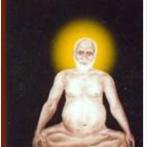Sri Gurubhyo namah Sri Parama Gurubhyo namah Sri Parameshthi Gurubhyo namah
Shantaa Vimalaa prakasha Atmaa Guhaa Chid Yogasya Sri Parananadadi Sadguroon Namamyaham punah punah
तटित्त्वन्तं शक्त्या तिमिरपरिपन्थिफुरणया
स्फुरन्नानारत्नाभरणपरिणद्धेन्द्रधनुषम् ।
तव श्यामं मेघं कमपि मणिपूरैकशरणं
निषेवे वर्षन्तं हरमिहिरतप्तं त्रिभुवनम् ॥ ४०॥
I worship that unique dark-blue cloud, abiding for ever in your Mani-pura, endowed with lightning in the form of the Sakti, whose lustre is dispelling darkness, with a rainbow formed by the sparklng of the dazzling gems set in the jewels (of the Kundalini), and showering rain over the worlds burnt by Hara (Fire) and Mihira (the Sun).
The names of the deities to be meditated upon in the Mani-pura-cakra are said to be Meghes’vara and Saudamani. They are also known as AmrtesVara and Amrtes’vari and are to be meditated upon by the practitioner as in the middle and surrounded by fifty two Apya (watery) Mayukha-s/ Dark-blue cloud—the form assumed by Meghes’vara. Sakti—known as Saudamani.
Darkness of the Mani-pura, which is the fifty-two Apya-mayukhas. They are rendered into a region of light mixed with darkness, i.e. Mishra loka, by the light effulgimg from the Kundalini Shakti.
There is the traditional view held that the rays of the Sun from the An-ahata, conjointly with the heat rays of the Fire of Swadhishthana convert the water of the Manipoora into clouds, which drench with their showers the world-conflagration caused by the Svadhishthana fire at the time of the Deluge. According to samaya tantra, the rays of Vayu in Anahata mix with the rays of fire in Swadhishthana and cool down into water upon entering Manipura.
The entire universe scorched by kamagni, the fire of desire, which resides in swadhishthana gets drenched and experience relief in Manipura.
Sadhaka gets relief during meditation when Kundalini reaches Manipura, where the clutches of Vasnas, Samskaras gets broken up.
There is also the reading, * Smara-mihira-taptam,* which means, ” consumed by the Sun of Desire “. * Hara-mihira’ is taken by some scholars, to indicate the twelve Aditya-s, of the form of Hara appearing at the Deluge to consume all the three worlds.
The following points culled from Laksml-dhara’s elaborate commentary on this stanza are noteworthy ;
The Siddha ghutika, a treatise on occultism, not known now to be extent, speaks of Sada-siva, manifestmg himself in the Manipura as a winter-cloud and shining there with his spouse of the form of resplendent lightning.
A chapter in the Taittiriya Aranyaka, has given a detailed description of the origin of the Sun, Moon and Fire and also of the stars and other luminaries making days and nights, all from water. Therein the essence of water—nectar, is referred to as pervading the disc of the Sun, and the Yogin is represented as the water of the Manipura asking for ” the essence of that essence, which is of the highest order “. The essence of water is explained to be the Moon. From the Ap-tattva of the Mani-pura, the Yogin desires to get at the Moon, the fountain source of all nectar, which is flowing from the lunar disc, passes on to the disc of the Sun, which it nourishes, as long as it flows.
Sri Shankara Bhagavatpadacharya worships Swadhishthna before Manipura ,because the Kundalini Path according to samaya differs from other systems. Moreover, Soundarya Lahari describes the psychic passage which is always superior.
In the spiritual journey there are two paths , jnana, knowledge and anubhava, experience. Path of jnana is guided by the buddhi, intellect whose basis is tarka, logic whereas the path of anubhava is based on purity and innocence guided by Shraddha. Both paths leads us to destination but the path of anubhava is no doubt superior.
Sublime truths were revealed to Sri Shankara because of purity and innocence in his prayer which cannot be found in books authored by intellectual giants. Even though the worship of Kulapatha in a different order to the other systems of Tantra, no one can discredit the experience of Sri Shankara.
Expressing Siva as dark blue cloud filled with water and Shakti as a streak of lightening in the cloud is very apt description and symbol of Manipura. Lightening is also a form in which shakti manifests. She is always electrifying, being the source of electromagnetic energy.
Moreover, Manipura is the centre where the ascending Kundalini shakes off the last vestiges, traces of impurities from the lower centres and becomes light and thus fully ensures the ascent.
Blog links to all 7 Soundarya Lahari Verses (36 to 42) to meditate 7 Chakras:
Verse 36 – Meditation upon Ajna Chakra
Verse 37 – Meditation upon Vishuddi Chakra
Verse 38 – Meditation upon Anahata Chakra
Verse 39 – Meditation upon Swadistana Chakra
Verse 40 – Meditation upon Manipura Chakra
Verse 41 – Meditation upon Muladhara Chakra
Verse 42 – Meditation upon Sahasrara Chakra
LOKA SAMASTA SUKHINO BHAVANTU SANASTA SANMANGALANI BHAVANTU





Very beautiful site
LikeLike
Thank you. Give feed back to improve
LikeLike
Pingback: Soundarya Lahari Verse 36 – Meditation upon Ajna chakra explained | Atmanandanatha
Pingback: Soundarya Lahari Verse 38 – Meditation upon Anahata chakra explained | Atmanandanatha
Pingback: Soundarya Lahari Verse 37 – Mediation upon Vishuddi Chakra Explained | Atmanandanatha
Pingback: Soundarya Lahari Verse 42 – Meditation upon Sahasrara Chakra explained | Atmanandanatha
Pingback: Soundarya Lahari Verse 41 – Meditation upon Muladhara Chakra explained | Atmanandanatha
Pingback: Soundarya Lahari verse 39 – Meditation upon swadhishtana chakra explained | Atmanandanatha